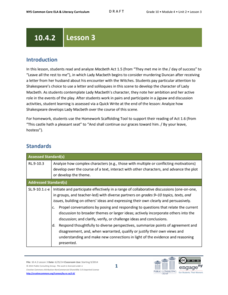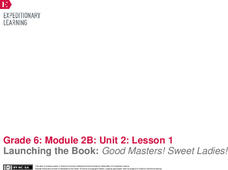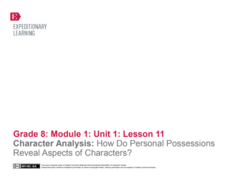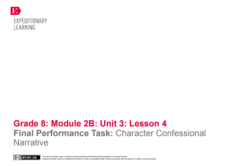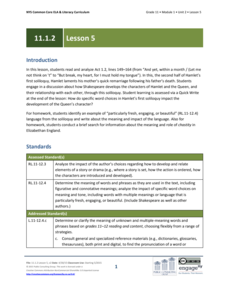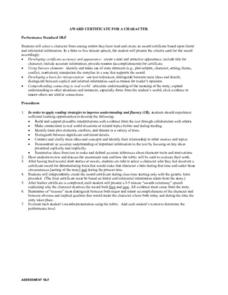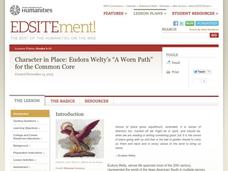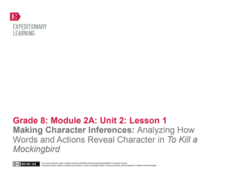EngageNY
Grade 10 ELA Module 4: Unit 2, Lesson 3
How does Lady Macbeth's ambition help advance the plot of Shakespeare's Macbeth? Scholars explore the topic using discussion and a jigsaw activity. Next, they complete a quick write to analyze how Shakespeare develops Lady Macbeth's...
EngageNY
Citing Evidence: The Ending of Pygmalion
Show time! After completing questions over Pygmalion section nine, scholars perform a reader's theater activity of pages 87-88. They then revisit their Eliza Character Trackers and add details as needed.
EngageNY
Launching the Book: Good Master! Sweet Ladies!
Every person has a different story to tell. Scholars take a quick look at the book Good Masters! Sweet Ladies! Voices from a Medieval Village. They discover that each character tells a different story. They then look at one...
EngageNY
Character Analysis: How Do Personal Possessions Reveal Aspects of Characters?
Learners use a jigsaw activity to examine characters in "Left Behind." Each group member focuses on a different character and then regroups to those with the same focus. Class members then return to their home groups for discussion...
EngageNY
Final Performance Task: Character Confessional Narrative
You wrote it, now what? Learners take their writing to the next level when they perform it for classmates. They then engage in a self-reflection and assessment of their work to determine how well they hit targets, such as identifying...
EngageNY
Grade 10 ELA Module 4: Unit 2, Lesson 4
Ambition, murder, nontraditional gender roles ... some problems just can't be fixed in marriage counseling. Learners discuss the relationship between Macbeth and Lady Macbeth. As a culminating activity, pupils analyze how the characters'...
EngageNY
Grade 11 ELA Module 1: Unit 2, Lesson 16
Using the resource, scholars read Act 3.3 of Shakespeare's Hamlet. They analyze two soliloquies and discuss how Shakespeare develops the characters.
EngageNY
Grade 11 ELA Module 1: Unit 2, Lesson 5
Scholars delve into Act 1.2 of Shakespeare's Hamlet. By completing a writing exercise and participating in a class discussion, they continue to analyze how the author develops the characters in the play.
Curated OER
Character Education Podcasts
Students study character traits. In this character education lesson, students create podcasts highlighting a particular character trait. Students broadcast one podcast per week.
Curated OER
"Split" Character Studies in Crime and Punishment
Young scholars write an essay evaluating split character traits on major characters in Dostoevsky's novel Crime and Punishment. In this lesson students are guided through discussion questions, group assignments, and vocabulary work. The...
Curated OER
Analysis Through Character Action/Beliefs
Students explore characterization. In this characterization lesson, students give analytical responses to questions and determine a character's beliefs. Students use the school mission statement to develop two beliefs that the statement...
Curated OER
AWARD CERTIFICATE FOR A CHARACTER
Connect to real-world experiences by having your primary learners create an award certificate based upon literal and inferential information from a story. They present the award to a character from a story and explain the criteria used....
Curated OER
A Boxful of Character
I can't wait to try this activity with my class. It's versatile and could be modified to fit any character analysis lesson. To analyze characters thoroughly, learners create life boxes. Each box will pertain to a character from any...
Curated OER
Writing a Tall Tale
Learners investigate tall tales. In this tall tales lesson, students read tall tales, then write their own. Learners focus on writing about exciting character development, plots, and scenes. Students edit and revise their papers...
Curated OER
Helping Others
Learners explore community service. In this character development and community lesson, students sing a song based on the fable The Lion and the Mouse. Learners participate in a discussion about kindness, and generate ideas for...
Curated OER
A Character's Perspective - Colonial House
Students write letters as colonists. In this point-of-view lesson, students watch a video about Colonial America, fill out a character development worksheet, and participate in a class discussion. Then students write a letter...
Curated OER
The Right Character Produces Positive Outcomes
Students explore the meaning of character and why positive character is important. They explain the difference between character and personality. Students determine the difference between right and wrong character. They explore the...
Curated OER
Character Traits
Sixth graders explore details from a story to develop ideas and opinions about character traits. Using a Smart Board, 6th graders create a chart explaining the character's action and traits. In groups, students discuss and describe...
Curated OER
Applying Character and Setting to Play Readings
Read Ira Sleeps Over, then identify elements of plays that are also common to books. Learners analyze character and setting, consider how these elements relate to a play, then write a one-paragraph skit using the characters from Ira...
National Endowment for the Humanities
Character in Place: Eudora Welty’s “A Worn Path” for the Common Core
How do writers use the interaction between elements like characterization and setting to create meaning? Readers of "A Worn Path" create a series of comic book-style graphics of Eudora Welty's short story and reflect on how Welty...
Literacy Design Collaborative
Identifying Points of View through Character Responses in R.J. Palacio's "Wonder"
Readers examine the book Wonder by R.J. Palacio to determine how characters respond differently to situations and events. Readers annotate and analyze the text and carry out group discussion using accountable talk. They work in small...
EngageNY
Making Character Inferences: Analyzing How Words and Actions Reveal Character in To Kill a Mockingbird
Partner up! After an I have/who has activity, readers partner with one of their discussion appointments to add evidence from chapters 11-13 in To Kill a Mockingbird to the Atticus Note-catcher. Partners then share with the class and add...
K20 LEARN
Conflict And Choice In Tangerine: Character Development
Introduce middle schoolers to Edward Bloor's novel Tangerine with a lesson that asks scholars to make predictions about events in the novel based on an article written by the Smoop Editorial team. Predictions are posted in the classroom...
Curated OER
Running Out of Time: Letter to a Character
Once your learners have a firm handle on the characters in Running Out of Time, invite them to write letters to chosen characters about the events of the novel. Pupils then share with others who wrote to the same character.
